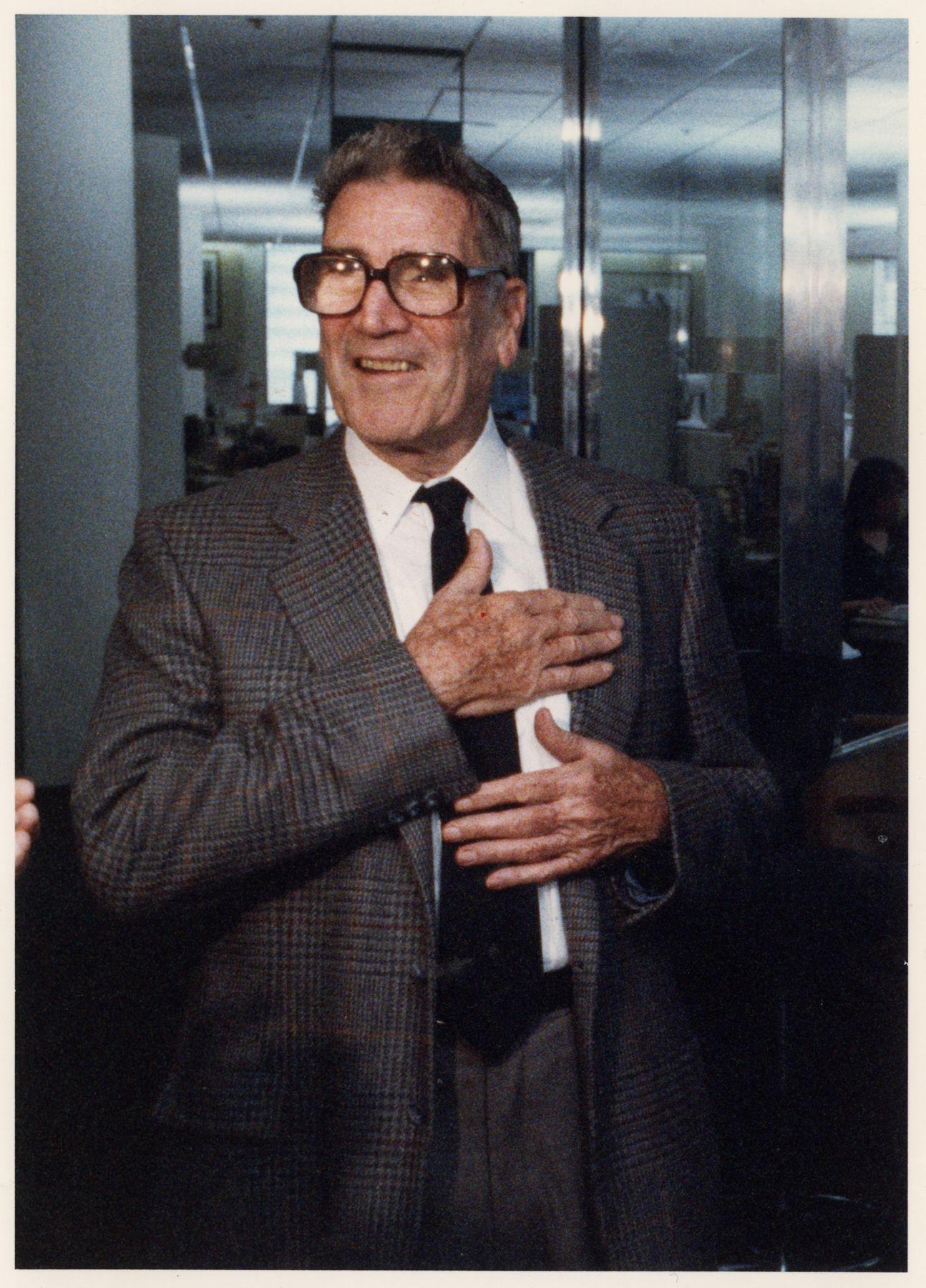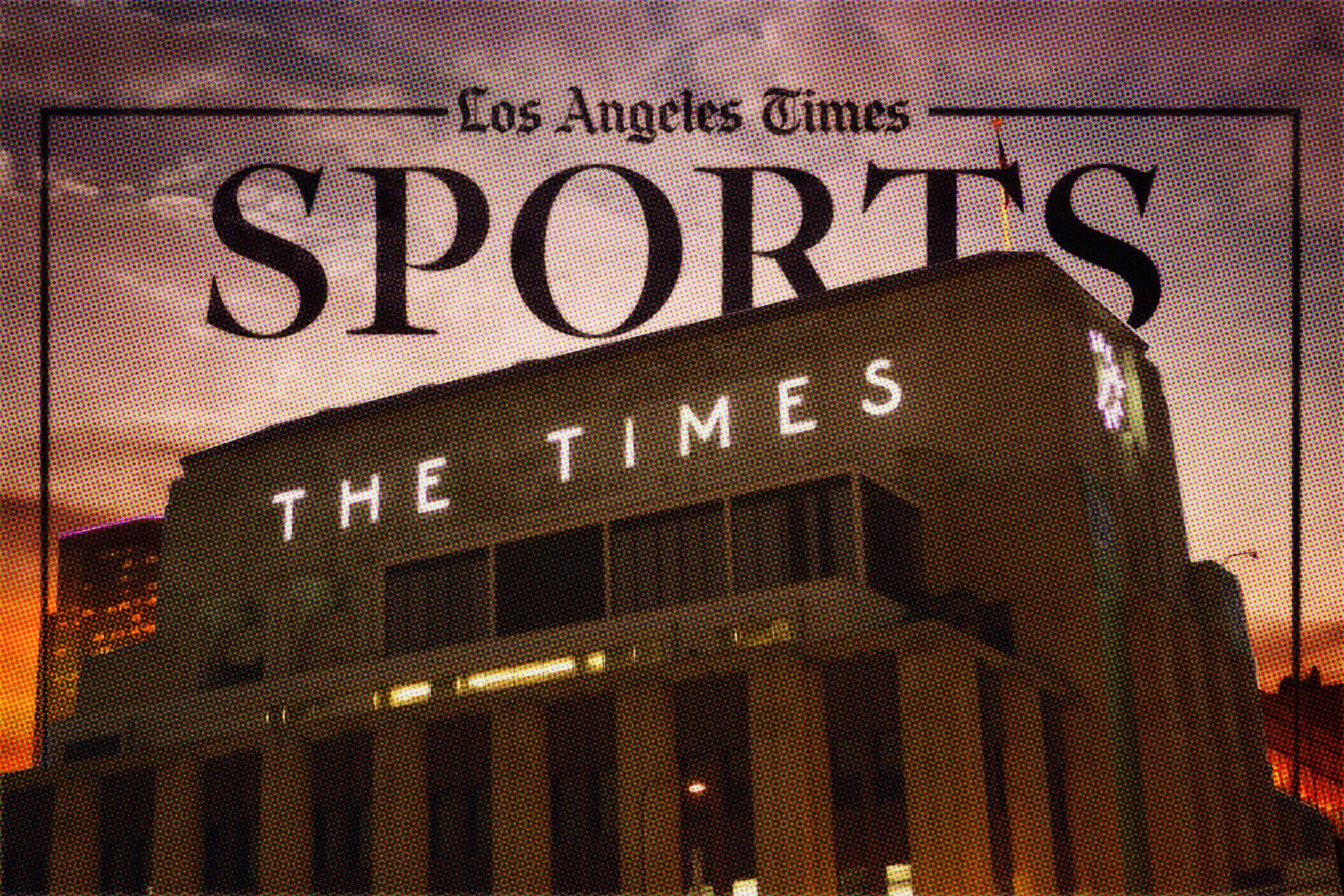Farewell to a Newspaper Office: The L.A. Times Sports Desk Bids Adieu
Los Angeles’s stalwart paper has a new owner and a new office. Departing and departed sports editors and writers share their stories about this palace of memorable (and deeply unmemorable) copy.In its final weeks downtown, the Los Angeles Times newsroom felt like a long-held army post that was about to bivouac somewhere else. There were orange pieces of paper stuck to the walls that said, “Fill your trash can every night.” Someone printed out a picture of the paper’s new owner, health care entrepreneur Patrick Soon-Shiong; put him in a Superman outfit; and had him flying over a rendering of the new Times headquarters in El Segundo.
One afternoon, Angel Rodriguez, the sports editor, showed me around. He pointed to a bank of executive offices that were empty. They belonged to two top editors, Davan Maharaj and Megan Garvey, who were fired in a purge last August.
“That was Kim Murphy,” Rodriguez said, pointing at another empty office. “A Pulitzer Prize winner. She took a job with The New York Times before the sale was announced. It’s all these vestiges of what was.”
The Los Angeles Times was leaving its 83-year-old headquarters for reasons that will feel familiar to the staffs of the Chicago Tribune and The Dallas Morning News. In 2016, during the period of wild mismanagement by the Tribune Company (and its rebranded spinoff, Tronc), the Times Building was sold to a Canadian development company. This spring, when Soon-Shiong agreed to buy the Times, he found the development company wanted to increase the paper’s rent by $1 million a month.
I asked for a tour because I wanted to see relics of the old Times sports department. Rodriguez had agreed to be my guide.
He led me past the desks in Metro (“This is the bastion of union organizing,” he said with a smile) to a far corner of the newsroom. On April 12, 1990, at 12:11 p.m.—the Times’ internal newsletter was precise on this—word came over the wire that sports columnist Jim Murray had won the Pulitzer Prize. Murray was surrounded by his colleagues in the newsroom. “All I ever did was quote Tommy Lasorda accurately,” he said. Rodriguez and I looked into a glass case that still held the congratulatory notes Murray got from Tom Brokaw and Steve Allen.
Next, we walked a few feet to a small set and TV camera that Bill Plaschke, one of the current Times sports columnists, used when he appeared on Around the Horn. The set used to be located in the sports department. But after a Tronc-induced reshuffling, Plaschke found himself delivering takes in the middle of the features department.
Rodriguez and I passed a glass case of Murray’s journalism awards and came to a large room in the middle of the building. This was the site of the current Times sports office. The room oozed with classic newspaper non-ambiance: the lighting was low and there were no windows that looked outside the building. The walls were painted a shade of gray-blue that Izod sports shirts used to come in 25 years ago. It looked like the office of an insurance agent who was thinking about selling out and enjoying life.
There were no sportswriters around: neither Plaschke nor the columnist Dylan Hernandez nor the Dodgers beat man Andy McCullough. That was appropriate. The old Times sportswriters’ motto was: “Keep your name in the paper and your face out of the office, and you’ll never get in trouble.”
The sports office was adorned with mock street signs that were printed with the names of some of the section’s alumni: Murray, baseball writer Ross Newhan, copy editor Harley “Ace” Tinkham. Along the wall, there were blue bound volumes that contained sports sections stretching back a few decades. Rodriguez opened to the October 9, 1993, edition—a time capsule from a distant, golden age of newspapering. “Two pages of agate,” he said with a trace of wonder in his voice. “We must have been rolling in dough.”
Getting romantic about a newspaper sports office is like getting romantic about a laptop. A newspaper office is at best functional and at worst a pain in the ass. Yet the Times leaving its old headquarters felt like the occasion for a tribute to the guys who used to work there. Not the writers. A sports page belongs to the writers. A sports desk belongs to the editors, and more specifically, to the night staff who served as the writers’ backstops, grammarians, and, occasionally, their nemeses.
Boys, I’m feeding the story into the teletype machine now. I hope it fits. I checked the facts as best I could. If possible, could you do me a favor and preserve the kicker?
Four decades ago, those that worked the Times sports desk at night were slick editors. They were sports encyclopedias in human form. Depending on the condition of the copy they had to handle, they were also amazing complainers. “At their best, they were hard-working, active professionals,” said Marshall Klein, who worked the desk in the ’60s. “But complaining? Oh, God, yes. That was better than the paychecks.”
Some of the desk staffers had been ace reporters before circumstances sent them “inside” to edit other reporters’ copy. “They weren’t real happy about being inside, and they didn’t care who knew it,” said Ron Rapoport, who was a reporter for the section in the ’70s. “The New Journalism was coming in. They grumbled about you describing what you were seeing, what the players were wearing—painting a scene. As opposed to, ‘The Dodgers beat the Giants, 4-2.’”
Yet the desk could also be great eccentrics. It was as though their fastidiousness with copy had to be counterbalanced elsewhere in their life. Take Ace Tinkham. A former decathlete and high jumper at USC, Tinkham had been a fine reporter. But a drinking problem sent him inside. When the Times’ night sports editor, Chuck Garrity, tried to assign him to cover a track meet in Northern California, Tinkham begged off. “I’ll just get drunk and thrown in jail,” he said. As writer and editor John Scheibe noted in his book about Murray and the Times, Tinkham often stopped at a drug store to buy his family presents on Christmas Eve.
Yet Tinkham was an enormously gifted, octopus-armed newspaperman. He could write a headline, edit, and rewrite a story from the ground up. His desk was stacked with out-of-town newspapers, which he’d pillage for the “Morning Briefing,” a collection of player quotes, trivia, and funny lines from other writers. Tinkham wrote the column until his death in 1990, which ended his 22-year run at the paper.
Frank Finch, another deskman in the ’70s, was such a fixture of L.A. sports that he’d covered the Rams when they moved to L.A. from Cleveland … in 1946. “Finch was like Michelangelo,” said Klein. “He didn’t have a first name or a last name. Everyone just referred to him as ‘Finch.’” If you heard someone call him “Frank,” you figured something was terribly wrong.
Once, when Finch was in a press box covering the Dodgers, he left his scorebook in the care of another writer while he went to talk to somebody. When Finch came back, he noticed the writer had scored a play an “8”—a fly out to center—with an exclamation point next to it.
“What’s this exclamation point?” Finch said.
“It was really a great catch,” his pal explained. “The best catch I ever saw.”
Finch replied, “I’ll be the judge of that!” It became a catchphrase around the sports section.
One night, Garrity noticed Finch was slipping away to the back of the sports office, opening a floor-level drawer, taking a nip of bourbon, and then returning to his work. I’ll fix him, Garrity thought. A figure from USC athletics had died that night, and Garrity assigned Finch to crash a deadline obituary. “He sat down, went to work on it, and turned out a great story in 15 minutes,” Garrity said. There was a reason Finch was like Michelangelo.
In an analog age, Avrum Dansky was a master of statistics. He was so exacting that he was known to call and correct an out-of-town Associated Press account. At night, Dansky used to amuse himself by answering the phone with a phony name: “Sports, Dansby.” “That’s the life of the night desk,” Klein said. “It could be very boring, so you’ve got to make stuff up or you won’t last till dinner.” Dansky’s colleagues did wonder, however, why he’d picked Dansby as his pseudonym.
Once, Dansky announced—to the shock of the desk—that he had a date and was taking her to Dodger Stadium. Later that night, he showed up for work at the Times. When the sports editor Bill Dwyre asked what happened, Dansky said, “I got to about the fifth inning and realized she couldn’t do an earned run average, so I just left.”
Another time, Dansky collapsed in the office and was taken to the hospital. He was back at work a few weeks later. Dwyre asked him why. “Dwyre, it’s basketball season,” Dansky said, before returning to his desk to do box scores. Later, when Dansky was at Good Samaritan Hospital, he complained that the hospital’s poor electrical wiring prevented him from listening to Dodgers games on the radio. When he died in 1992, he left a small fortune to the hospital so they could fix the wiring.
The Times sports department was a self-contained kingdom in both the physical and editorial senses. “I couldn’t pick out the city desk,” said Rapoport. “It was over there somewhere.” On election nights, the metro staff would announce with great fanfare they were staying late to make sure the results got in the paper. The sports desk rolled their eyes. The Dodgers and Lakers had an “election” almost every night.
People who worked in sports dressed more casually than their counterparts. They followed games on TV or radio and cheered if their favorite team scored. Everybody rooted against overtime, which just messed with their deadlines. “And slow pitchers,” said Klein. “Jesus. They shouldn’t have a rosin sack.”
If a reporter was found to be in (as it was gently called) “no condition to file,” a desk editor might be hustled to the Forum as a fill-in or else told to write a gamer off the radio with the reporter’s byline. One night, an Angels writer forgot to submit the “How They Scored” material with his game story. The writer later called to apologize—he’d been in a rush because his son was waiting in the car. Dansky announced to the office, “Just another reason not to get married and have kids!”
As the stories came in, Garrity would glance at the lede and then hand it off to the desk. “One of my favorite young guys—he wasn’t there very long—was covering the Dodgers,” Garrity said. “He wrote a poem like Grantland Rice would have written and sent it in. I read it, and I thought, ‘Holy shit, what is this?’ I called him, and I said, ‘Are you gonna rewrite this or you want me to?’” Before Tinkham could begin his rewrite, Garrity heard the teletype machine clicking away. The writer had gotten the hint and turned his poem into a piece.

If a copy editor was lucky, they got to handle Jim Murray’s column, an experience Klein compared to getting copy from Moses. Murray had his own tics. He’d insert an odd word in his column as if checking to see whether the desk was awake. He had no interest in statistics. “He had a column one night that said, ‘Babe Ruth hit about 700 home runs,’” Garrity said. Dansky corrected it because the exact number seemed kind of important.
Garrity said the Times had four edition deadlines between 7:30 and 12:30 at night. After the sports copy editors closed an edition, they might start a game of catch. “One night,” Scheibe wrote, “the football sailed over the partitions that separated sports from the rest of the newsroom, and it landed on the desk of Al Bluhm, the executive news editor. Bluhm walked back holding the ball and said in a voice that crackled with doom, ‘I suggest you put this away.’”
Larry Stewart, who worked for three decades as a copy editor and sports TV columnist, remembers eating dinner between editions in the heavily subsidized Times cafeteria on the 10th floor. Relations between the Times and the LAPD were more cordial then, and at night, the cafeteria filled with cops cadging a cheap meal.
Life on the desk largely existed apart from the money that was coursing through the Times, which by the ’70s was transforming from a glorified L.A. real estate guide into a journalistic powerhouse. In 1981, Otis Chandler, the scion of the family that owned the paper, walked into Dwyre’s office. “I didn’t know if he wanted to execute me or give me a raise or what,” Dwyre said.
He took Dwyre to a room on the sixth floor of the building that housed the company’s art collection. Now that Dwyre had joined the editorial elite, Chandler explained, his office ought to look the part. “Otis and everybody else knew this was the procedure,” Dwyre said, “and figured the sports editor would pick out a couple of volleyball posters.” Instead, Dwyre selected two fine paintings by the Mexican artist Rufino Tamayo. They were installed in his office and stayed there for 15 years.
After putting the final edition to bed, the copy editors often repaired to the Redwood—a bar that’s still open, in slightly different form, on Second Street. Paul Zimmerman, the old sports editor, maintained a booth there, and paying customers were expected to scram when he showed up. At the Redwood, there was a red telephone hanging from the wall. This editorial Batphone, Garrity said, had an extension on the Times switchboard.
Any good desk editor could write the next few paragraphs from muscle memory. Thanks to technology and mismanagement from Chicago, the fortunes of the Times turned downward. The sports staff had to fight to protect its cherished domain. A top editor once asked Dwyre whether he could move the copy deadline to 10:15 p.m. Sure, Dwyre said, the Dodgers and Angels writers will file in the seventh inning and maybe take a whack at guessing the result of the game.
The lean years changed the look of the Times Building itself. In 1996, Dwyre got a call informing him that the Times Mirror Company was beginning to divest its art collection. Dwyre’s Tamayos were traded for two Pablo Picasso lithographs—still pretty gaudy for a sports editor but hardly the glittering originals.
In 2015, after Dwyre had stepped down as sports editor and was writing a column, he took a buyout. He came to the Times Building and turned in his entry badge. Afterward, Dwyre realized he’d left something in his office. He went back and knocked on the door. No one answered. He knocked some more. Then he gave up and left. “It was a knife in the heart when I was knocking on that door,” he said. “It was nobody’s fault. It was just that everything had changed so much.”
On our tour, Rodriguez took me to the Times publisher’s office, which had been deserted and locked since the last publisher was reassigned by Tronc in February. Later, we looked at a swath of empty cubicles on the second floor that had been used and then vacated by Tronc executives. They were the eeriest kind of occupying army—the kind that left behind neat and tidy desks.
Despite the shadow of Tronc, the sports section Rodriguez presides over is the highest-functioning part of the paper other than Jonathan Gold’s restaurant column. “We might not be as big as before,” Rodriguez said. “But we still find our fastball every once in a while.” Plaschke is a columnist that makes total sense once you live in Los Angeles, McCullough owns the Dodgers beat, Dan Woike is the smart and resourceful Chargers writer, and Nathan Fenno writes evocative crime stories. The night staff has retained its old character, with editors like the recently retired Mike Davis and Steve Horn. When there’s a funny headline in the paper, someone will remark, “That’s a Steve Horn headline!”
The Times sports section, like every newspaper sports section, is caught between the scrappiness required by new media and that old newspaper hauteur. There’s a semiofficial Times rule that the front page of a section should never contain wire copy, just original copy from Times reporters. This year, the Times didn’t have a writer at Game 6 of the Eastern Conference finals. It was clearly the biggest story in sports. Not wanting to be the editor who broke the rule, Rodriguez put a photo of LeBron James on Page 1 and put the wire story inside.
Though the drive to El Segundo will double or triple the length of some editors’ commutes, Rodriguez thinks Soon-Shiong, a minority owner of the Lakers, will be good for the sports department. Rodriguez has resisted producing a regular podcast because he doesn’t have the facilities to do it correctly—facilities that will presumably be available at the headquarters. He’s also hoping to hire more writers. These are the kinds of things you need to fend off a challenge from the L.A. branch of The Athletic.
The old Times Building shouldn’t be compared to a cathedral because the best things that happen at a newspaper are by definition heretical. If the site of the old sports desk has historical value, it’s because it was the dayside headquarters of Dwyre and the nocturnal playpen of Tinkham and Finch and Dansky. They edited some extremely memorable sportswriting and some extremely unmemorable sportswriting and usually made both tighter and more correct.
“Beyond nostalgia, I feel great sadness,” said Klein, who left the desk and became sports editor of the Times’ Orange County edition. “No matter what I did, what I became known for, those were the times of my life.”
“I’ve been out of the business so long I can’t tell you what it’s like now,” Klein continued. “But I can tell you what it’s not like. It’s not like it was.”


